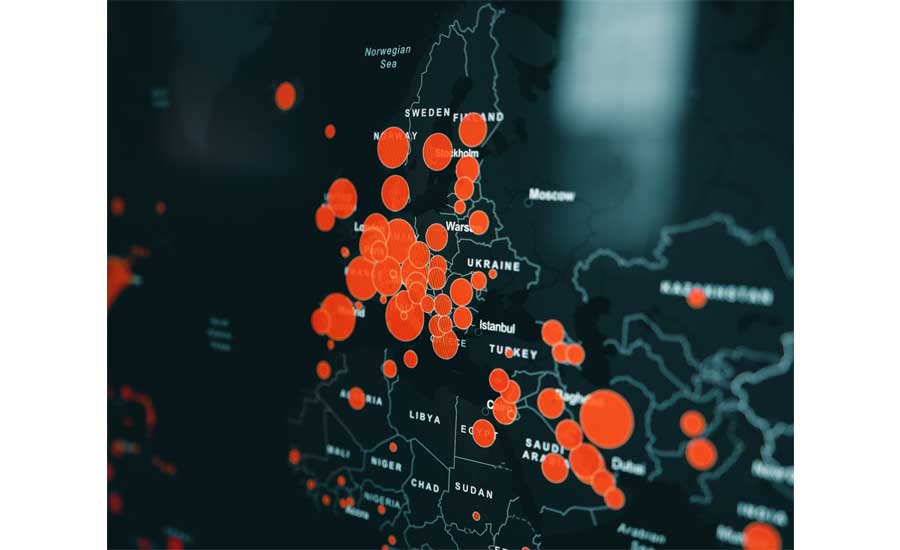The ACHR NEWS spoke with William Bahnfleth, ASHRAE presidential member and professor of architectural engineering at the Pennsylvania State University and founding director of its Indoor Environment Center, about the impact of COVID-19 on the HVAC industry and the kinds of IAQ solutions contractors can offer to their customers in response.
ACHR NEWS: How do filters, UV, and other HVAC technologies help control the spread of viruses, and how effective are they?
Bahnfleth: In the ASHRAE position document on airborne infectious diseases, three methods of controlling airborne infection are identified that actually have proof of efficacy. One is ventilation, and the other two are particle filtration and UV.
Any air cleaner that removes particles has some potential to get rid of coronavirus. The question is, what efficiency of filter is effective enough that it will have a significant impact on how likely people are to get affected by the airborne route? And that's something else we should talk about. Even HEPA filters that have been tested in the laboratory with viruses will have some level of penetration. Not much — 2 percent. But if anything gets through, and if it's a very virulent pathogen, that doesn't mean that you're perfectly protected against infection by that filter. Same thing with UV. There's definitely UV susceptibility of coronaviruses ... it's maybe somewhat less than the net of influenza, but still susceptible. So if you were treating contaminated air or contaminated surfaces with UV, you could expect to reduce the concentration of coronavirus on it by some amount.
ACHR NEWS: One of the big questions for the HVAC world is how significant is airborne transmission of coronavirus?
Bahnfleth: The current consensus is that the transmission is predominantly large droplet transfer from people coughing or sneezing within a fairly close range of other people — 6 feet is what the CDC is saying. The larger the droplets are, the faster they will fall to the ground or other surfaces. If I were to cough or sneeze in your direction unprotected, some of the virus-containing droplets coming out of my mouth or nose might enter your mouth, eyes, or nose and cause an infection.
Then there is the door knob/toilet seat theory of fluid transmission: that is, infectious material, say from someone coughing or sneezing into their hand, touches a surface, and then somebody else touches it and then touches their own eyes or mouth. The transfer is done that way, and that’s why people use paper towels to open the bathroom door.
There's also the potential for airborne transmission. And if viruses that are viable are in those droplets that you're producing, some of them will be small enough that they will stay airborne for a long time. So, it's not impossible that infectious particles in the air could stay aloft long enough to be collected, say at the return grille of an HVAC system, go through a duct, and infect someone in a different space.
While you can’t rule out airborne transmission entirely, it's probably not the only and maybe not the predominant mode of transport. Because there are three distinct ways of transmitting an infection, even perfect control of airborne pathogens would not eliminate all risk
ACHR NEWS: What can be done to help protect against airborne particles that might be circulated by the HVAC systems if they get up there?
Bahnfleth: One thing that reduces risk is having 100 percent outside air system. Dedicated outdoor air systems are becoming popular; they don't recycle the air from one space to others.
Air filtration is a good idea, but it's got to be pretty high-efficiency filtration because the particles that are infectious are going to be pretty small. The MERV 8 filter that you're required minimally to put in under Standard 62.1 isn't very effective against particles of that size. In terms of the MERV scale, you probably need to be putting in a 13 to start to have a specific effect on PM 2.5 sized particles. Otherwise, it’s going to be passing through a lot of the small ones that may be may be infectious.
Keeping surfaces clean is also important, and there are plenty of [UV] devices around now that are used mainly in healthcare environments to disinfect surfaces during unoccupied periods. One of the things that we’ve researched at Penn State is cooling coil irradiation systems. I've been told by some people who've been doing it for years it keeps the coils pretty much like new.
ACHR NEWS: What kind of questions do you anticipate that contractors’ clients are going to be calling about, and what can a contractor recommend?
Bahnfleth: Better filters; humidity control; maybe room air cleaners if you don't have a central system in with high efficiency; filtration; and if you can get good home UV products, some manufacturers will put those into your furnace air conditioner for you. It’s basically the same solutions as we would use in other types of buildings, but packaged for the residential market.
If you've got a central a/c system, one thing you can do is look at putting in better filters, which is something I did in my own house. We had a really low efficiency filter, basically just a metal screen filter in our air handling unit, and we found that we could put in MERV 13 filters and it runs just fine — it just means that the system runs a little bit longer, which is actually better in cooling season because it's used to humidify.
Just running the fan with the cooling off, to keep circulating air through it, will help remove particles. The big problem with the filters in home air conditioning equipment is that the systems are not doing anything when they're off, so you have to intentionally make it run to circulate air if you want it to be a whole house air cleaner. Filtration can be done in the room, too; local air filtration may be a better way to deal with this large droplet kind of stuff.
Another thing that has emerged is paying attention to relative humidity. The recommendation for a long time has been to try to keep minimum relative humidity between 40 and 60 percent, because viruses are least viable in that range. Many commercial buildings have humidity control to keep conditions in this range, but in a home in the winter — especially if it's leaky and in a cold climate — humidity drops into the 20s or lower. A well-maintained home humidifier that keeps your relative humidity at the recommended level is a good idea.
ACHR NEWS: Is there anything contractors should avoid saying or recommending?
Bahnfleth: From my experience, the important thing to keep in mind is that infection control usually doesn't have a silver bullet. Risk reduction involves doing a number of different things, and engineering controls — like putting in better filters or putting UV into your building — is not the only thing you should do. If I were a contractor, I’d be prepared to suggest to a homeowner other things they might do that are not necessarily HVAC-related to reduce infection risk. Things like hygiene, being careful about whether you touch your face, whether you're shaking hands with people, whether you're washing your hands frequently — those, in many ways, are just as important as doing the right things with your HVAC.








